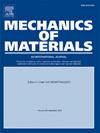丙烯腈-丁二烯-苯乙烯材料挤压增材制造:实验及取向角的各向异性模型
IF 3.4
3区 材料科学
Q2 MATERIALS SCIENCE, MULTIDISCIPLINARY
引用次数: 0
摘要
测定了挤压增材制造(ME-AM)丙烯腈-丁二烯-苯乙烯(ABS)材料的屈服应力随应变速率和取向角的变化规律。采用不同取向角的水射流切割方法从ME-AM加工板中提取单向试样。通过印刷矩形板,可以应用恒定长度的股线轨迹。因此,材料的热力学历史在整个板上尽可能相似。通过使用阿基米德原理确定样品的平均孔隙率,屈服应力值可以补偿ME-AM样品中存在的空隙。结合Eyring流动规律和Hill各向异性,建立了一个与时间和取向相关的模型,将屈服应力描述为应变速率和取向角的函数。该模型采用可分解方法,即两种效应解耦,简化了模型参数的确定。基于各向异性连续体的粘弹性Eyring-Hill模型能够充分预测复杂的实验屈服应力行为,这是一项具有挑战性的任务。扫描电镜断口分析显示,由于在股方向上的破坏,宏观上更具延展性。宏观脆性行为与链间破坏有关。本研究是ME-AM零件结构完整性预测的重要一步,因为时间和取向依赖性在蠕变和疲劳行为中也很重要。本文章由计算机程序翻译,如有差异,请以英文原文为准。
Material extrusion additive manufacturing of Acrylonitrile-Butadiene-Styrene: Experiments and anisotropic model for the orientation angle
The yield stress as a function of both strain rate and orientation angle was measured for material extrusion additively manufactured (ME-AM) Acrylonitrile-Butadiene-Styrene (ABS). Unidirectional test specimens were extracted by waterjet-cutting at different orientation angles from ME-AM processed plates. By printing rectangular plates, a strand trajectory of constant length can be applied. Thus, the thermo-mechanical history of the material was as similar as possible across the plate. By determining an average sample porosity using Archimedes’ principle, yield stress values could be compensated for the voids present in ME-AM specimen. A time- and orientation-dependent model, which combines an Eyring flow rule with Hill anisotropy, was used to describe the yield stresses as a function of strain rate and orientation angle. The model uses a factorizable approach, i.e. both effects are decoupled, which simplifies the determination of model parameters. This anisotropic continuum-based viscoelastic Eyring-Hill model is able to adequately predict the complex experimental yield stress behavior, which is a challenging task. Scanning Electron Microscope fractography revealed macroscopically more ductile behavior due to failure in the strand direction. Macroscopically brittle behavior was related to inter-strand failure. The present study is an important step towards the prediction of structural integrity of ME-AM parts, as time- and orientation-dependency are also important in creep and fatigue behavior.
求助全文
通过发布文献求助,成功后即可免费获取论文全文。
去求助
来源期刊

Mechanics of Materials
工程技术-材料科学:综合
CiteScore
7.60
自引率
5.10%
发文量
243
审稿时长
46 days
期刊介绍:
Mechanics of Materials is a forum for original scientific research on the flow, fracture, and general constitutive behavior of geophysical, geotechnical and technological materials, with balanced coverage of advanced technological and natural materials, with balanced coverage of theoretical, experimental, and field investigations. Of special concern are macroscopic predictions based on microscopic models, identification of microscopic structures from limited overall macroscopic data, experimental and field results that lead to fundamental understanding of the behavior of materials, and coordinated experimental and analytical investigations that culminate in theories with predictive quality.
 求助内容:
求助内容: 应助结果提醒方式:
应助结果提醒方式:


